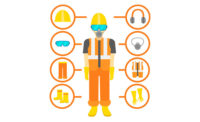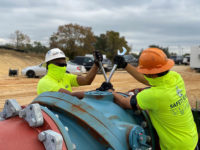Construction work remains one of the most dangerous occupations in the United States in 2022. Potential hazards abound, from falling objects to dangers involving footing, balance, and the inability to adequately see and hear. Most job sites are replete with electrical tools and heavy machinery, which greatly increases the potential for on-the-job accidents, especially when proper precautions are not adhered to.
The most typical types of dangers associated with job site construction include, airborne material exposure, slipping or tripping on concrete surfaces, struck by incidents (including a vehicle, a falling object, a projectile or any facsimile thereof), scaffold and ladder related injuries and burns.
Thankfully, the private sector is hard at work addressing these various dangers in new and exciting ways, most of which incorporate smart technology, with advanced engineering and tried and true solutions from the past. Smart devices can respond to both the body of the worker and the environment to deliver crucial information to both the worker and, often, the supervisor.
Next-generation hard hats
These hard hats are the epitome of wearable mobile technology. These multi-faceted protection devices are made by companies like SmartCap and are designed to monitor the fatigue level of workers by monitoring EEG (brainwaves). They are also designed to implement early warning alerts and alarms which enables a worker to monitor his, or her, alertness levels.
Smart safety vest
Commonly seen at any job or construction site, a traditional safety vest does little more than raise the visible profile of the wearer. Smart vests and similar garments utilize a wide range of features which could play a key role in creating and maintaining a safer work environment. From garments that make use of LEDs and sensors to further increase visibility in low-light environments to vests designed to detect the wearer's vital signs in order to alert them of any abnormalities, smart vests are something that industry professionals can expect to see a whole lot more of in the days ahead.
Safety glasses
Augmented reality (AR) is a technology that uses glasses, goggles or similar devices in order to provide users with an added layer of visual information. Next-generation safety glasses can provide construction workers with insight regarding unsafe temperatures, the status of on-site equipment or highlight other aspects of the worksite that may pose a potential safety hazard. AR can also be of benefit in terms of visualizing various aspects of construction projects or ensuring that workers are less likely to suffer from distractions when performing a task.
On-site sensors
Remote sensors provide information regarding unsafe noise levels. They help monitor temperature and other environmental changes and alert workers of the presence of volatile compounds and other hazardous materials. Ensuring proper placement and antenna alignment for all broadcast equipment and devices can even decrease response time in the event of an accident or life-threatening emergency. Some of these sensors and systems will even summon help automatically and can be a crucial resource in the event that an accident victim becomes incapacitated or unable to call for help.
Maintaining a safer work environment
While access to the right tools, equipment, and other resources goes a long way toward minimizing the risk of an accident, creating and utilizing the right safety policies and protocols will prove to be of tremendous importance. Construction companies are well served to take stock of their operation and to identify areas where safety is a concern.
PPE is, of course, an essential part of workplace safety, and new equipment will ensure that employees feel safe on the job. Every construction worker should be able to come to work with confidence that he or she won’t get injured while working. Equipment manufacturers are making sure this happens with each new development. Innovative PPE provides employees with more options about what kind of gear they wear and what it can do for them. Providing more choices can reduce worker injuries and increase employee satisfaction. However, as any job safety manager will attest to, PPE is a tool like any other, and must be utilized in tandem with good work practices and quality control that must never be substituted for.
Smart tech segments in personal protective equipment companies are increasing rapidly. The year-over-year growth rate for 2019 was projected to be 15.41%, according to a report from Technavio. Rapid growth means that companies offer more choices and new devices to protect workers. The same report predicts a compounded annual growth rate of more than 16% in smart tech personal protective gear and a $2.55 billion increase in the market, with about 36% of the market growth in North America.
With that said, it appears that the new high-tech choices available to construction managers are revolutionizing the industry which is good news for workers and manager alike.




